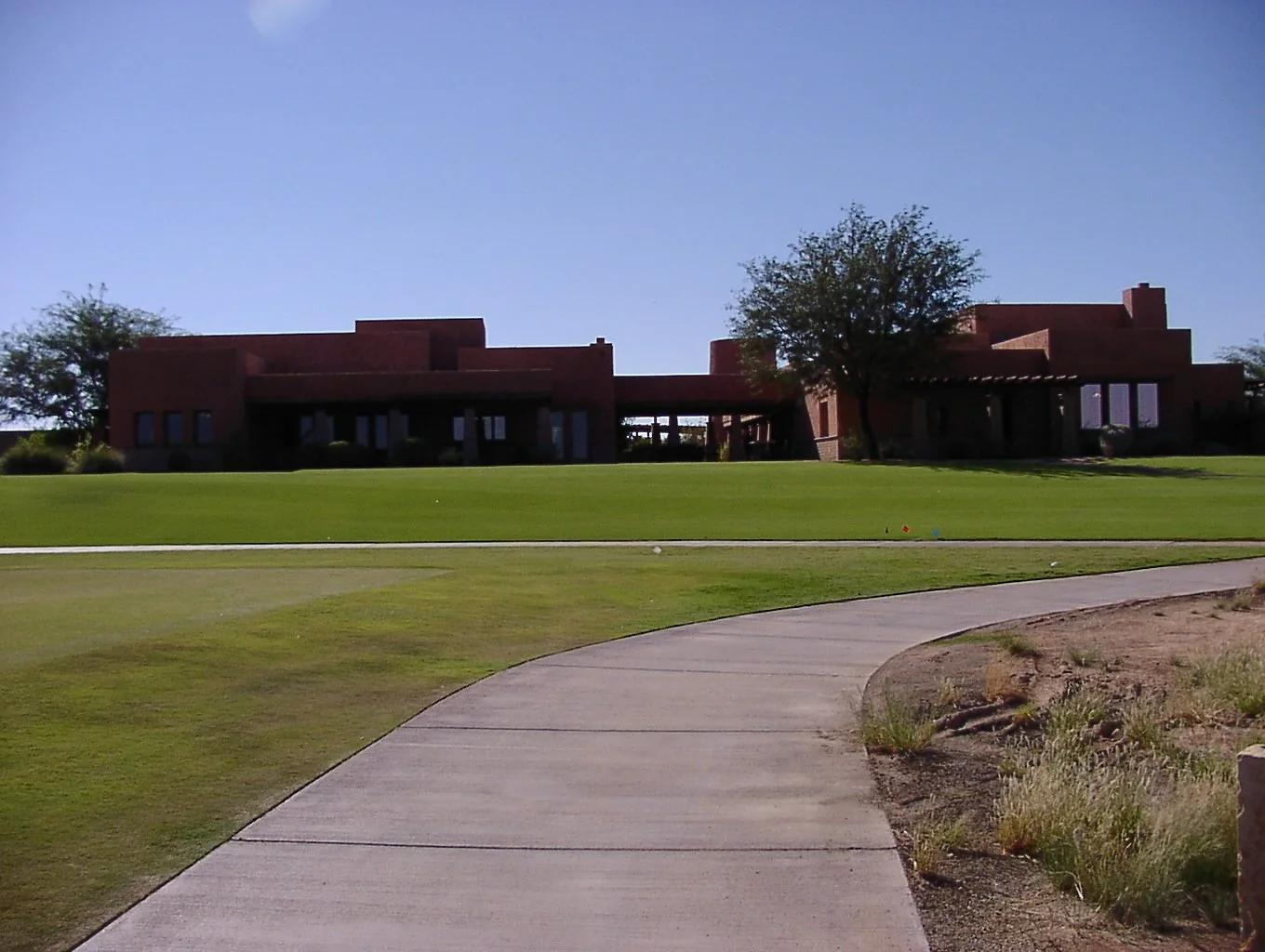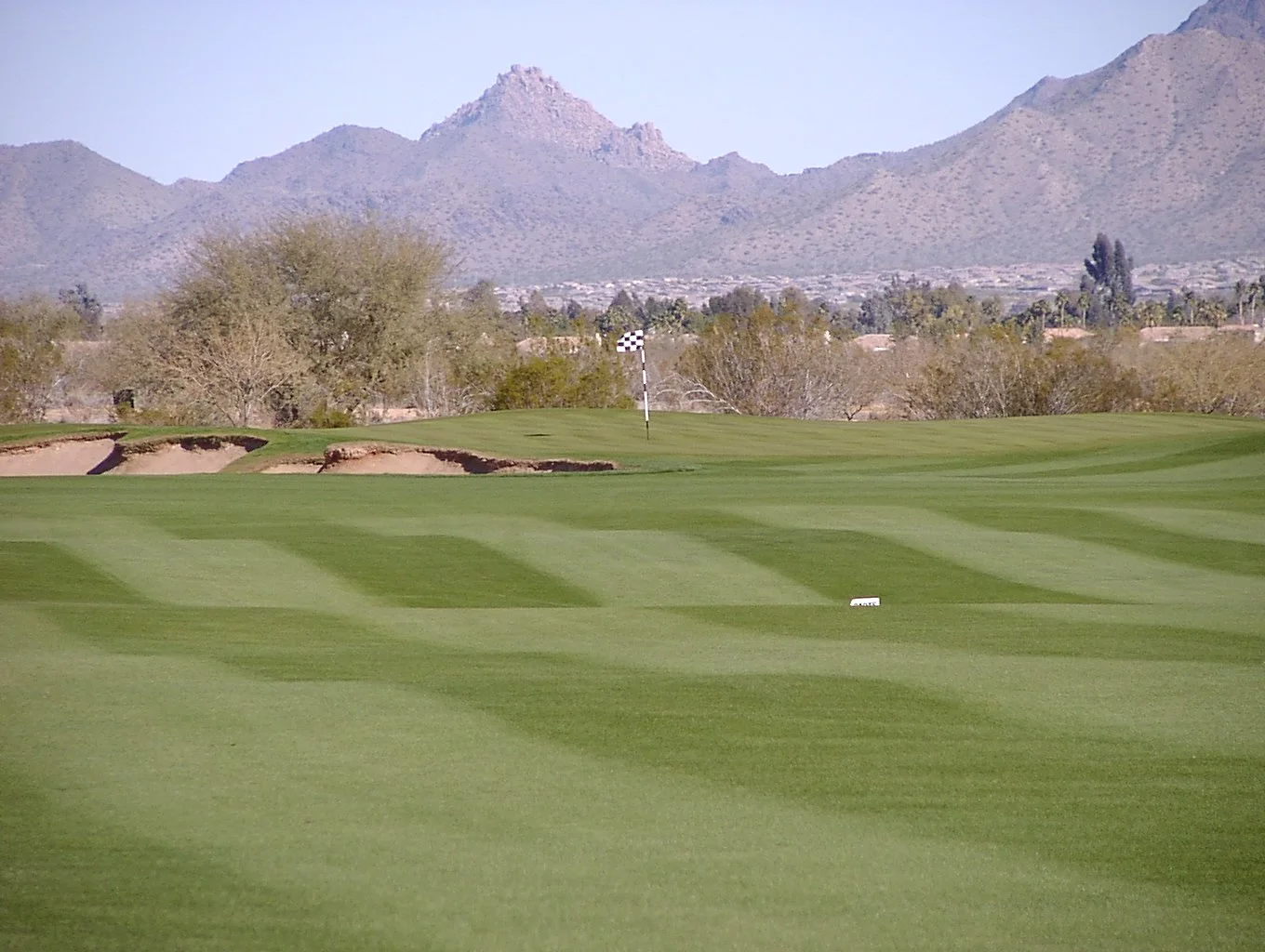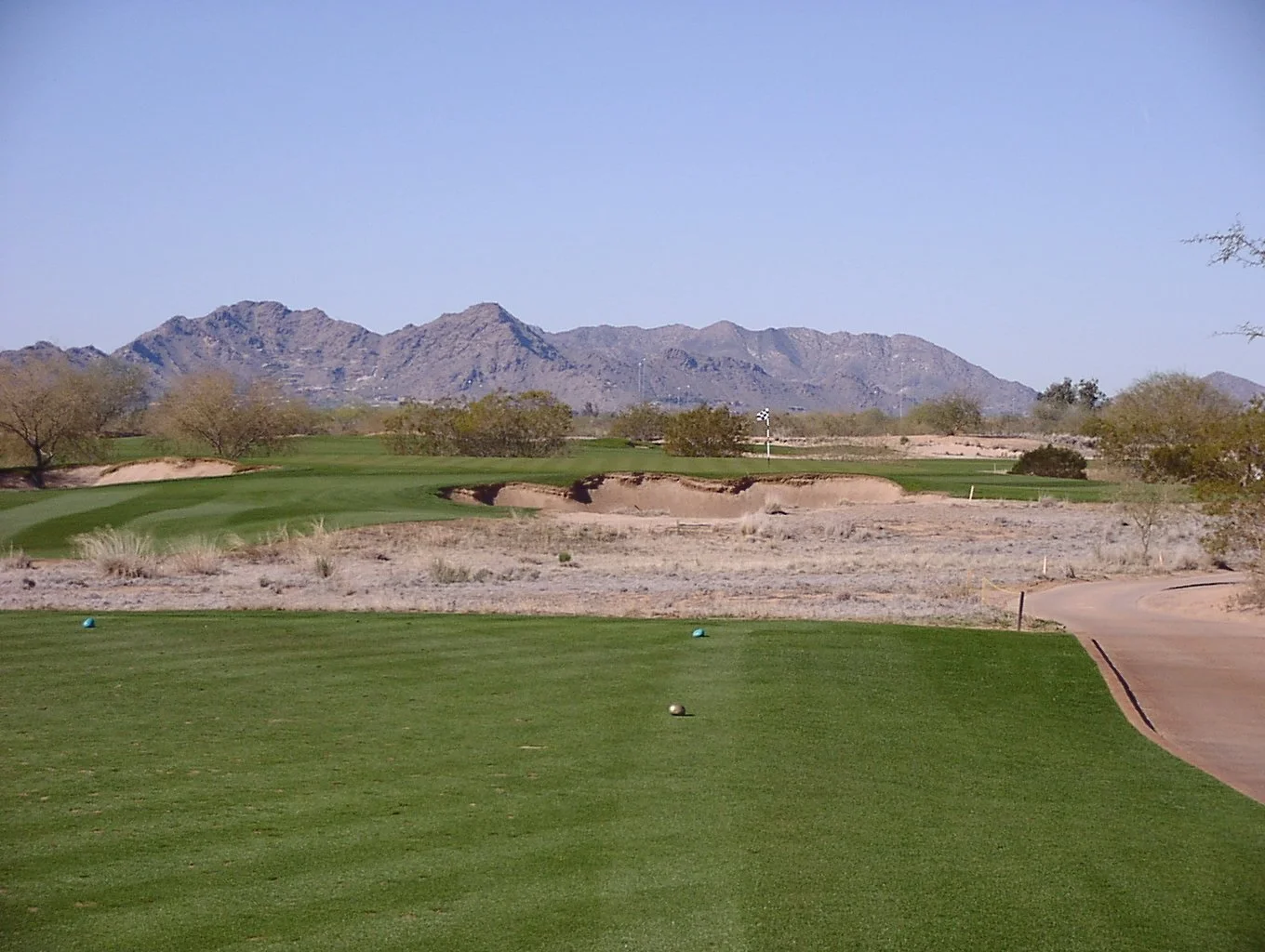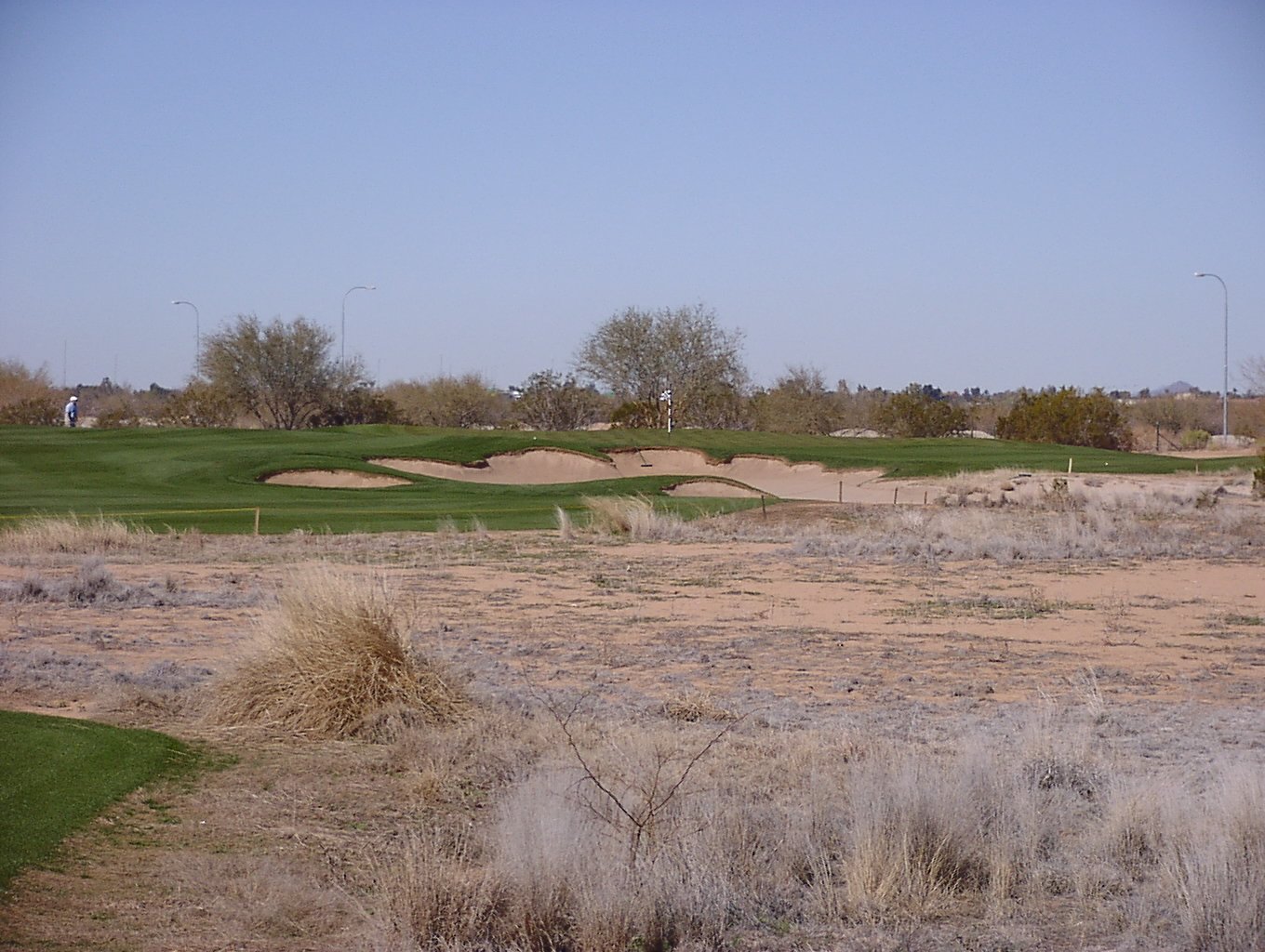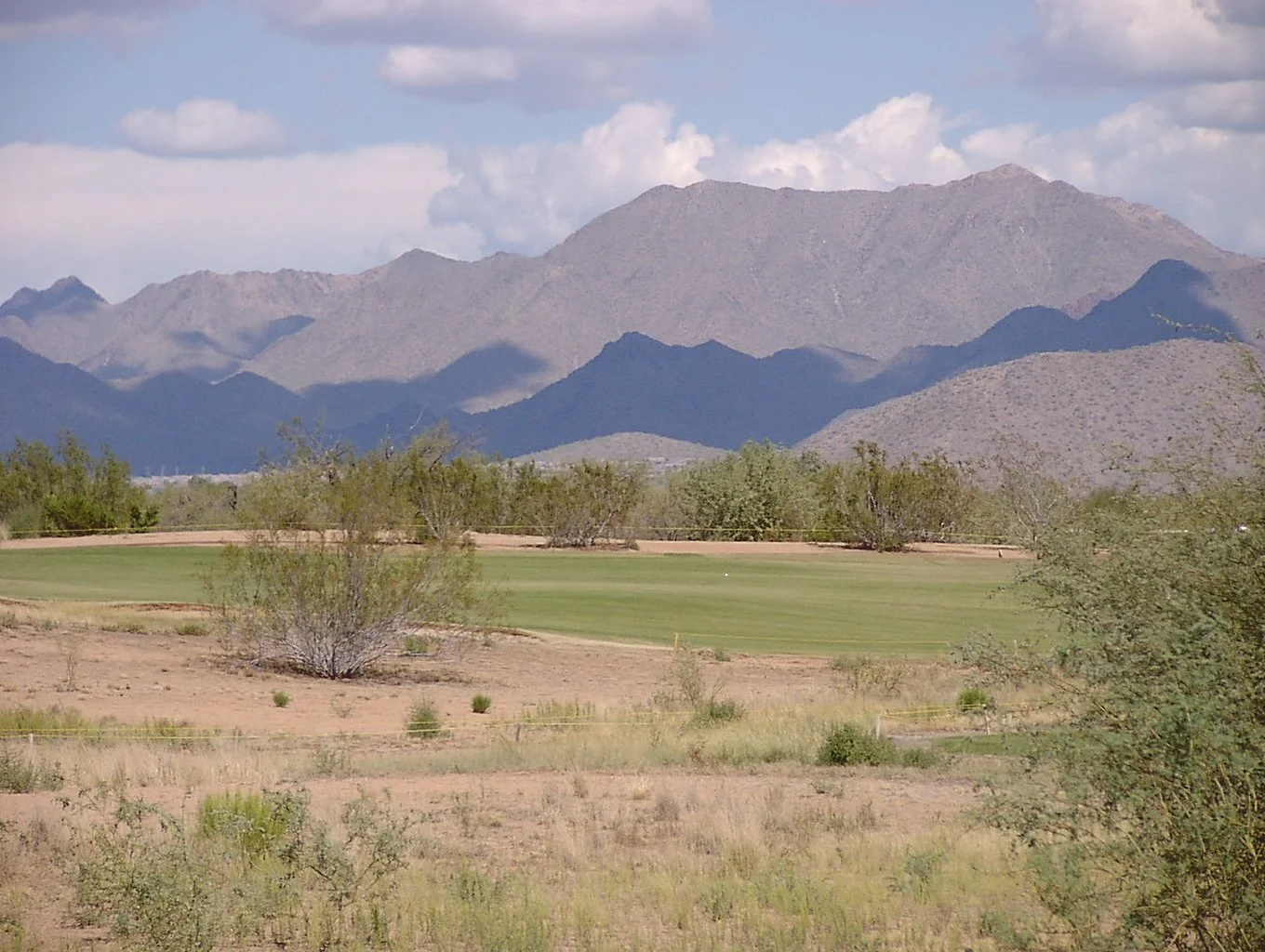TALKING STICK GOLF CLUB (NORTH COURSE)
Course Architects: Ben Crenshaw and Bill Coore
Year Opened: 1998
Location: Scottsdale, Arizona
Slope: 123. Rating: 72.7
Par: 70
Yardage: 7,133
Hole-by-Hole: 1 - Par 4 394 Yds 10 - Par 4 437 Yds
2 - Par 5 552 Yds 11 - Par 3 261 Yds
3 - Par 4 450 Yds 12 - Par 4 392 Yds
4 - Par 4 433 Yds 13 - Par 4 391 Yds
5 - Par 4 391 Yds 14 - Par 4 445 Yds
6 - Par 3 223 Yds 15 - Par 4 461 Yds
7 - Par 4 457 Yds 16 - Par 3 194 Yds
8 - Par 3 153 Yds 17 - Par 5 582 Yds
9 - Par 4 446 Yds 18 - Par 4 471 Yds
Par 35 3,499 Yds Par 35 3,634 Yds
Awards Won: Best New Course in the State Arizona Republic Newspaper (1997),
#1 - America's Best Courses, State by State (Golfweek, 2002-04),
#97 - Top 100 You Can Play - Golf Magazine (2002-03),
100 Best Golf Shops - Golf World Business (2000-04),
Rated Four Stars - Places to Play - Golf Digest (2004).
Key Events Held: PGA Tour Qualifying School (1998-99),
USGA Mid-Amateur Sectional Qualifier (1998, 2002),
AGA 4-Ball Championship (1998),
National Club Championship for Women (1998),
AGA Mid-Amateur Championship (2003),
USGA Women's Publinks Qualifier (2003),
The Gateway Tour (2002-04),
USGA Women's Mid-Amateur Qualifier (2004).
Website: Talkingstickgolfclub.com
HISTORY: In just a short period of time, Talking Stick has gained some national prominence after hosting the PGA Tour's Q-School in 1998-99 and has been ranked as the top public access course in the state of Arizona for the past three years.
Located on land and owned by the Salt River Pima-Maricopa Indian Community, Talking Stick features 36 holes of outstanding golf, with more of it residing on the North Course. It was designed by the team of Ben Crenshaw and Bill Coore, who have crafted some outstanding gems across the country like Sand Hills in Nebraska, the Plantation Course at Kapalua and Hidden Creek in New Jersey.
The name "talking stick" is derived from two different meanings...one is that the talking stick was an ancient calendar of important events for the Pima tribe with some of the events depicted on the stick, such as those of harvests, droughts, solar eclipse, and festivals; the other is that a stick was passed around to the person who wanted to speak at a tribal meeting and that, in fact was its origin. The truth will never really be known and the stories will evolve from one generation to the next.
Hawaiian professional Regan Lee owns the course record on the north as a result of his shooting a 10-under-par 60 in 2002. Not bad considering the fact that he made a bogey to go along with his nine birdies and one eagle.
REVIEW: Good news and bad news await you on the first tee. You'll notice that the fairways are large and accommodating, that's the good news. The bad news, this course does not have a par-four under 390 yards, and 16 of the 18 greens are over 30 yards in depth with the bunkering around the course is reminiscent of Scottish links. So, lock and load and, hopefully, be ready to
wield a hot putter.
The first hole bends slightly to the left off the tee, requiring a three-metal off the box. A wedge remains to a fairly large, round green that slopes from back-to-front. Sand protects the surface left and right, while a pot bunker stands 50 yards short of the green. A definite birdie hole, but not a bad one with which to start off with par.
The second is aptly named the "Boundary", as the entire left side borders the desert. Another big fairway, so rear back, turn and just pound one out there to give yourself a shot at the green in two, provided you keep it straight down the middle, or close to it. Two bunkers guard the right side of the putting surface, while just 15-20 feet to the left is out of bounds. There is no margin for error, so miss right and try to get up-and-down for birdie. The green is the narrowest on the course at just 18 yards and is one of only two that are under 30 yards in depth.
You will certainly need your driver off the tee on three. However the farther down the fairway you go, the tighter it gets, as numerous sand bunkers protect the right side landing area. A mid- to
long-iron will be required for your second, as you attack a fairly flat green. Miss short and right and you'll find yourself in one of the deepest bunkers on the course.
Rated the hardest hole of this eighteen, the fourth is a great par- four with abundant choices, hence the name "Three Roads". Play left and you'll leave yourself a mid- to long-iron to the green. Miss right and you still might catch a piece of fairway, but chances are you'll hit sand or desert or both. Go straight and, well, you'll need a 240-yard carry over first desert and then encounter sand from which to reach the fairway. Not a lot of breathing room here. A big tee ball will leave only a short- to mid-iron to a green that slopes from back-to-front with sand left and right. When Joey Snyder shot 62 during his final round on the Gateway Tour, this was the only blemish on his scorecard, as he made a not so memorable bogey.
The only place on the fifth hole that is taboo, is dead-center of the fairway. So much for hitting it straight down the middle. A pot bunker resides some 240 yards out from the back tees, placed directly in harm's way. Nobody I know, however, hits it that straight. A short-iron will be left to the most protected green on the course, flanked back, left and front by sand. The putting surface is just 23 yards wide with slight undulation, right-center. This is your last legitimate attempt at birdie for the next few holes.
The first par-three on the course, the sixth is a bear of a hole. It measures 223 yards from the tips so the more adventurous, daring and confident among you will need all you have, especially if playing into the wind. To make matters worse, the putting surface is quite difficult sloping several different ways and is over 40 yards in length. By the way, miss the green right or left and two deep bunkers await.
Another big tee shot is needed on the straightaway seventh, as it stretches 457 yards. You'll still have a mid- to long-iron left to a green that slopes, as Clint Eastwood said, "Every which way but loose." A back-right pin is next to impossible, so take your par or bogey and move on.
Club selection will be key if you want a chance at birdie on the eighth. A scant 153 yards, this hole can be had, especially when the wind is down. Avoid the sand short and left and you can get one back.
The outward nine closes with another rugged par-four, that features a tighter landing area, protected by three bunkers (one left and two right). A medium- to long-iron remains to one of three greens over 40 yards in depth. Make certain that you are aware of the mound left and right on the putting surface as well as the with a bunker on the right. Making par here will be a blessing in disguise or better yet, "surprise," as you head for the longer back nine.
The bottom line on the inward holes is to take the driver out and keep it out. Let's start out with the 10th, a par-four that not only requires accuracy off the tee, but length as well. A pair of fairway bunkers strategically placed guard each side of the landing area. A mid- to long-iron takes you left to a green that features two mounds in the center of the surface. No bunkers around the green, just closely shaved chipping areas.
Usually par-three's are rated as the easiest holes on the course but not the 11th. From the back buttons, you'll need driver, as the hole plays 261 yards. Would you believe a small cannon? It's 210 yards just to carry the desert and bunker 40 yards shy of the green. A hogback in the center of the surface is the green's lone obstacle. Your short game will be definitely tested.
A signature hole if there ever was one, the 12th is a gem. Nicknamed, "Red Mountain Gambler," this 392-yarder really only has one option, although the big hitters will test their brawn. The main fairway sits off to the right, setting the hole as a dogleg left. A 50-yard wide desert gulch (waste bunker) stretches straight ahead from the tee, 237 yards from the back buttons. It then narrows to a ditch, splitting the fairway and fronting the green. You have to see it to believe it. The smart money is to play right and leave yourself with a wedge to a narrow green that slopes
to the front with three mounds dotting the surface. This is one of the easiest holes to birdie and to double-bogey. That's golf's version of the ultimate oxymoron.
The 13th is a dogleg right and gives the player a chance to get one back, most likely his last chance. Trying to cut too much off at the corner will result in bogey or worse, so play out left and leave yourself a short-iron to a green protected left by sand. The surface is deep at 36 yards, but not too undulating.
Another big tee shot will be required on the 14th and make sure you stay right of the fairway bunkers that dot the left side. A medium-iron will remain to a deep green that slopes from back-to-front with a bunkers left and right. If the pin is on the right side of the surface, don't short side yourself as you will be hard pressed to keep your bunker shot on the green. There is no shame in bogey at at this one and forget the eraser you have in your bag. Golf pencils do not come with any and with good, obvious reasons...this is one of them.
A 230-yard tee shot is needed to carry the bunker that guards the fairway on the 15th. That being said, you'll be left with a mid-iron to an oval-shaped green that is the longest on the course at 42 yards in depth. The putting surface features a couple of knolls and slopes from right-to-left. Take your par and move on.
The last of the one shotters, the 16th is right in front of you. No gimmicks, just 194 yards to an average-sized green with a couple of humps and bumps. Not really a birdie hole, but certainly a hole to make par.
The final par-five on the course, the 17th is also the longest at 582 yards from the black tees. If the fairways are firm and fast, a player certainly has a chance to reach the green in two. However pinpoint control is a must, as bunkers dot both sides of the fairway off the tee and the fairway
narrows on its approach to the green. The putting surface is quite tricky with a hogback in the center and small mounds in the front and right, as well as a deep bunker to the right. Par is a must, birdie a possibility.
A fitting finish to an outstanding course, "Trail's End" typifies the Crenshaw and Coore philosophy of strategy, beautiful bunkering and natural appearance. A 230-yard bomb down the right side over two fairway-guarding bunkers will leave a mid- to long-iron to a deep, but narrow green. The putting surface is flanked by a pair of deep, long bunkers, while the green slopes several different ways. Just pick yours. If you make par here, your better than most.
OVERALL: Standing on the first tee, a large wide-open fairway awaits and you think, "Oh, this course should be simple". What foolish mortals we be. The fact of the matter is that you'll be mistaken. Just because the fairways are ample, doesn't mean that this is an easy course. Far from it. Remember, this is a par-70 that stretches over 7,100 yards with four par-fours over 450 yards and two par-threes over 220, including a 261-yarder.
There is no rough to speak of which means that if you miss the fairway you're in the desert and
your chances of escaping cleanly is slim and none.
The views of Camelback and the McDowell Mountains as well as Pinnacle Peak are outstanding. Bringing a camera along for a later trip down memory lane or a blow up to adorn your den or office wall might be a good idea.
Talking Stick is quite different from your typical Scottsdale-style venue of target golf. Wide fairways, no trees, strategically placed bunkers, flat landscape and a natural setting. In a few words, what you see is what you get. "The North course, with its broad, angular holes rewards thoughtful play through the rise of its many options according to one's level of skill," commented the design duo. "Its low-profile, slightly crowned greens and close- cropped approaches encourage running as well as aerial assaults." To coin a phrase, this is a "minimalist" design with beautiful vistas of the surrounding area. But what makes this place so special is the outstanding bunkering on every hole. That which sets these architects apart from most designers is their imagination with sand and their use of the land.
This course will make you employ all your clubs as well as every shot you've ever learned or feel you are capable of attempting with reasonably anticipated results, from flying the ball to the hole or punching it in under the wind. Rest assured that you will be tested. The course is for all levels of play, as it stretches from 5,500 yards to over 7,000. However there are only three sets of tees.
Not to be forgotten are the outstanding course conditions from tee-to-green...absolutely immaculate. The staff is very knowledgeable and the pro shop is well stocked with a great selection of clubs and clothes. Finally, the practice facility. How about a 25-acre driving range that includes two large teeing areas with space for nearly one-hundred hitting stations. The
range provides a grass hitting surface and sand bunkers guarding the target greens to help the golfer's visualization.
To top it off, the golf school is run by Tim Mahoney, ranked as one of Golf Digest's 50 Greatest Teachers. All rounds include range balls, yardage books, bag tag, divot tool and cart and the price is right.
Talking Stick is a must play for the avid golfer who loves a challenge. As was stated in a somewhat memorable film, "I'll be back."

